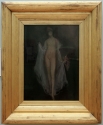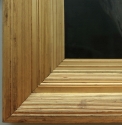The Paintings of James McNeill Whistler
YMSM 494
La Sylphide

Date
La Sylphide may have been painted in Paris at some time between 1896 and 1900. 1

La Sylphide, The Hunterian
The form of the butterfly signature indicates such a date. It was seen in Whistler's studio in 1902 by Charles Lang Freer (1856-1919), Detroit, who described it as a 'Young girl with whitish grey drapery over shoulders and arm - front nude. chair in distance at her right, in her left hand a red fan - on her head a pale red cap V f.' (meaning 'Very fine'). 2
Images

La Sylphide, The Hunterian, University of Glasgow

La Sylphide, The Hunterian, University of Glasgow

La Sylphide, frame detail, The Hunterian

La Sylphide (infrared photograph), The Hunterian

La Sylphide (ultraviolet photograph), The Hunterian

A girl in a red cap, The Hunterian, University of Glasgow
Subject
Titles
Whistler's original title is not known. Only one title is known, which may derive from Whistler's sister-in-law, Rosalind Birnie Philip (1873-1958):
- 'La Sylphide' (1915, Colnaghi). 3
- 'La Sylphide' (1980, YMSM). 4
'Sylphide' is french for sylph, an imaginary or mythical spirit of the air. However, the term is also used to describe a slender woman or girl, and from that point of view, is appropriate.
Description

La Sylphide, The Hunterian
A figure study in vertical format. The standing figure of a very young, slim woman, her nudity accentuated by the completely transparent robe that covers her body, gathered in at her neck. Over this she wears a white robe, which is held out at both sides, revealing her body. Her left arm is held slightly out to the side, and she holds a half-open pale pink fan. She also wears a plum-coloured cap. The floor is dark, the wall behind her, a yellowish brown, deeply shadowed at left. Behind her, at the far left, is a white chair.
Site
The canvas may have been acquired and painted in Paris. The white chair in the background was originally in Whistler's Paris studio in the Rue Notre Dame des Champs, and is now in the Birnie Philip Collection in the Hunterian.
Sitter
The model has not been identified.
Technique
Composition

La Sylphide, The Hunterian

A girl in a red cap, The Hunterian
Variations on the pose are seen in drawings by Whistler. The pose, in reverse, is similar to that in Green and Blue: The Dancer m1376, dated ca 1893. Although the legs are further apart, another comparable pose is seen in a later pastel, A girl in a red cap m1468.
Technique
The measurements of the canvas correspond to the French 'toile de 12' and it has a very open plain weave typical of Whistler’s canvases acquired in Paris. There is a thin white priming on the canvas, presumably a commercial one, and a thinly applied mid-grey imprimatura.

La Sylphide, The Hunterian
A full technical examination of this painting was carried out in the School of Culture and Creative Arts Technical Art History laboratory in the Hunterian at Kelvin Hall in February 2020. Professors Joyce H. Townsend and Margaret F. MacDonald examined the paintings under a microscope. A high resolution camera for infra-red reflectography (IRR) was operated by Tess Visser, a PhD student supervised by Professor Christina Young, assisted by Alicia Hughes, Hunterian curatorial assistant; images were also made of the recto in normal, raking, and ultraviolet light, and of the verso. The results are summarised below.

La Sylphide (infrared reflectogram), The Hunterian
The infrared reflectogram does not give any evidence for underdrawing, which would, if done in graphite pencil, have been discernible through such thin paint. Neither does it show any compositional changes. Raking light images also indicate that the paint is thin throughout.
The composition is a tonal study, with the draped figure placed first, on the dark grey imprimatura that would later serve for the floor without further painting. Then the warmer pink walls were lightly painted, with the brushstrokes following her outline. The drapery was further defined, with later pink brushstrokes reinforcing the warmth of the flesh seen through the fabric. The gauzy fabric, though it is sketchy, has its lower border clearly and economically defined by a continuous stroke of grey paint, that reads almost like a pure white against the darker background colours of the room. Bone black can be seen under magnification in all the paint, including this “white”, and the flesh tones.
The fan was painted at a later stage and relatively thickly, and the skirting board that defines the interior space even later: it runs up to the fan, not under it. The chair at left was first painted as a dark flat shape using thinned dark grey paint, then given form and more presence with lighter grey brushstrokes in the same paint used for the skirting board. The first light brushstrokes for the flesh paint are surprisingly grey when viewed under magnification, and were applied at the same time as the drapery. The pearly skin tones were then built up with thin applications of lighter, warmer pink paint that includes a very pale pink organic pigment, rather than the redder ochres Whistler often used to depict flesh paint if he used a less dark background colour or imprimatura. Red vermilion is absent too: pinks and greys define the composition even at the microscopic level, in a carefully constructed colour harmony.
There are numerous signs of alterations: the drapery, for instance, originally extended further left. Her head is small in relation to her body, with curiously abbreviated features, and is unconvincingly positioned in relation to her neck.

La Sylphide (ultraviolet photograph), The Hunterian

La Sylphide, The Hunterian
The face is unfinished, the last working having consisted of rubbing down. The hair was painted with a long-haired and soft brush, which gives a feathery outline to the paint. Elsewhere, it is obvious that 6.5mm (¼ inch) brushes were used, one for each colour: black, cap colour, fan, pale grey for the drapery, flesh colour, and the colour of the right arm seen through gauzy fabric. The pink cap was relatively thickly painted, and the pinkish background colour behind it was rubbed or washed away round it to make the colour stand out in the composition. Some details were added boldly: the hem of the cape, for example, is outlined in a broad wavy brushstroke.
There are microcracks at the top of a few canvas threads, suggesting very light abrasion, and only light rubbing down for the flesh paint. In the more diaphanous fabric, there is light rubbing down, removing small amounts of paint but not so much as to reveal the tone of an earlier brushstroke. Separate long brushstrokes made with a soft long-haired brush have marbled very slightly, suggesting thinner or medium modifier was added to this paint. (Thinner makes paint look matte, and was clearly used here, whereas medium modifier serves to bring back the natural sheen of oil-based paint.)
Conservation History
The varnish is of natural resin type, fairly evenly brushed. It covers the whole sight area, and hence was not applied in a frame. It is not much yellowed. It overlies Whistler’s butterfly signature, and appears to be the earliest varnish applied since no conservation treatment is known to have occurred. But since the canvas was not exhibited in his lifetime, it could nonetheless have been applied posthumously.
Frame

La Sylphide, The Hunterian

La Sylphide, frame detail
A Grau-style frame, dating from ca 1900. 5 Size: 92.2 x 76.9 x 7.6 cm.
History
Provenance
- 1903: in Whistler's studio at his death, and bequeathed to his ward and executrix, Rosalind Birnie Philip (1873-1958);
- 1958: bequeathed by Miss R. Birnie Philip to the University of Glasgow.
Exhibitions
It was not exhibited in Whistler's lifetime. It was first shown at Colnaghi's in London in 1915. Walter Richard Sickert (1860-1942) complained about the titles of the works, stating that Whistler cried out in them ‘for the qualities he failed to get within the rectangle of his frames. The catalogues are full of “gold” and “silver”, of “amethyst” and “opal”.’ 6 What Sickert perhaps did not realise was that the works exhibited in 1915 did not necessarily bear Whistler's own titles, but titles filtered through the memory and mythologising of his sister-in-law and art dealers.
Bibliography
Catalogues Raisonnés
- Young, Andrew McLaren, Margaret F. MacDonald, Robin Spencer, and Hamish Miles, The Paintings of James McNeill Whistler, New Haven and London, 1980 (cat. no. 494), plate 318, as 'La Sylphide'.
- MacDonald, Margaret F., James McNeill Whistler. Drawings, Pastels and Watercolours. A Catalogue Raisonné, New Haven and London, 1995 (cat. no. 576).
Authored by Whistler
- None.
Catalogues 1855-1905
- None.
Journals 1855-1905
- None.
Monographs
- None.
Books on Whistler
- None.
Books, General
- Sitwell, Osbert (ed.), A Free House! or The Artist as Craftsman, being the Writings of Walter Richard Sickert, London, 1947, p. 35.
- Robins, Anna Gruetzner (ed.), Walter Sickert: the Complete Writings on Art, Oxford, 2000, p. 388.
Catalogues 1906-Present
- Loan Exhibition of Works by James McNeill Whistler to aid the Professional Classes War Relief Council, Messrs Colnaghi, London, 1915 (cat. no. 27).
- Young, A. McLaren, Glasgow University's Pictures, Colnaghi, London, 1973 (cat. no. 69).
- ホイスラー展. Whistler Exhibition in Japan, Isetan Museum of Art, Tokyo; Hokkaido Museum of Modern Art, Sapporo; Shizuoka Prefectural Museum, Shizuoka, 1986, p. 193 (cat. no. 36).
Journals 1906-Present
- Sickert, Walter Richard, 'A Monthly Chronicle / The Whistler Exhibition', The Burlington Magazine, vol. 27, 1915, pp. 169-70.
Newspapers 1906-Present
- Anon., 'Unexpected Whistlers', The Glasgow Herald, Glasgow, 1 June 1915.
- Anon., 'Art & Artists', The Observer, London, 6 June 1915.
Websites
- The Hunterian website at http://collections.gla.ac.uk/#/details/ecatalogue/41212.
- Art UK website at https://www.artuk.org.
Unpublished
- None.
Other
- Parkerson, Sarah Lawrence, Variations in Gold: The Stylistic Development of the Picture Frames used by James McNeill Whistlers, PhD thesis, University of Glasgow, 2007.
Notes:
1: YMSM 1980 [more] (cat. no. 494).
2: n.d., [1902], Diaries, Bk 12, Freer Gallery Archives.
3: Loan Exhibition of Works by James McNeill Whistler to aid the Professional Classes War Relief Council, Messrs Colnaghi, London, 1915 (cat. no. 27).
4: YMSM 1980 [more] (cat. no. 494).
5: Dr S. L. Parkerson Day, Report on frames, 2017. See also Parkerson 2007 [more].
6: W. Sickert 1915 [more]; W. Sickert 1947 [more], p. 35.